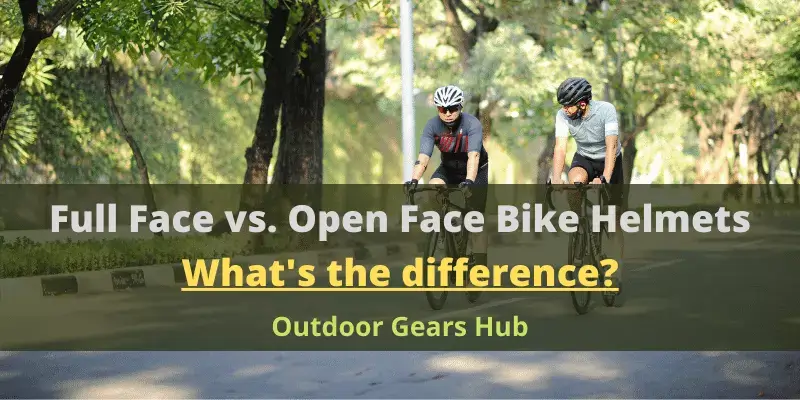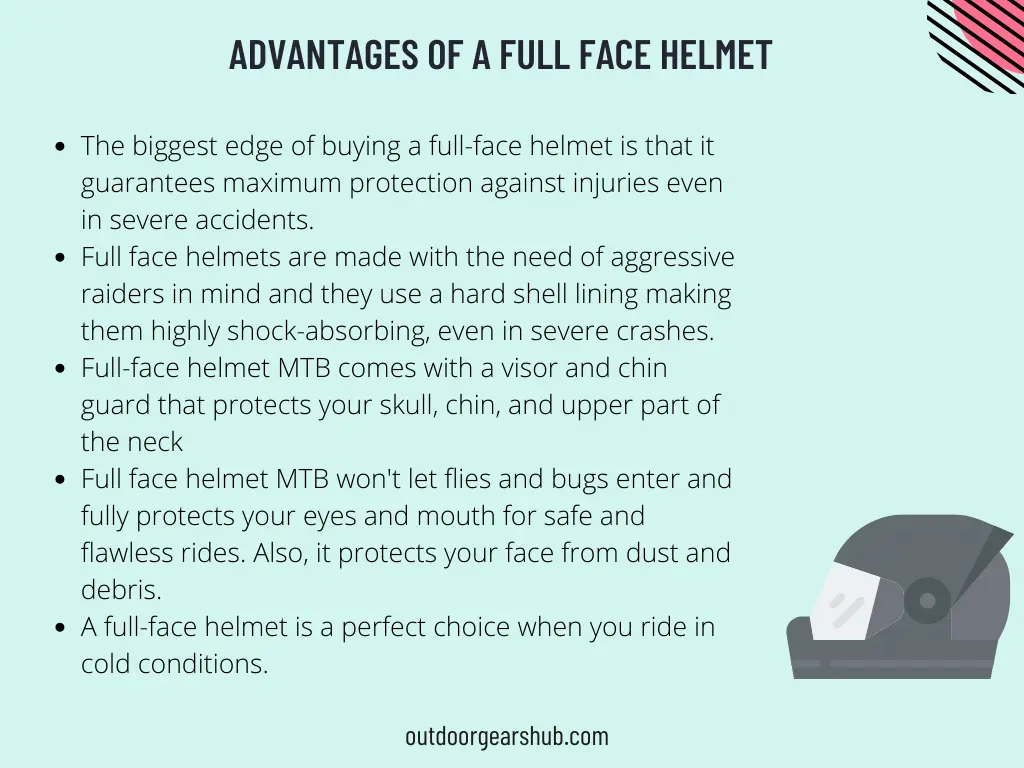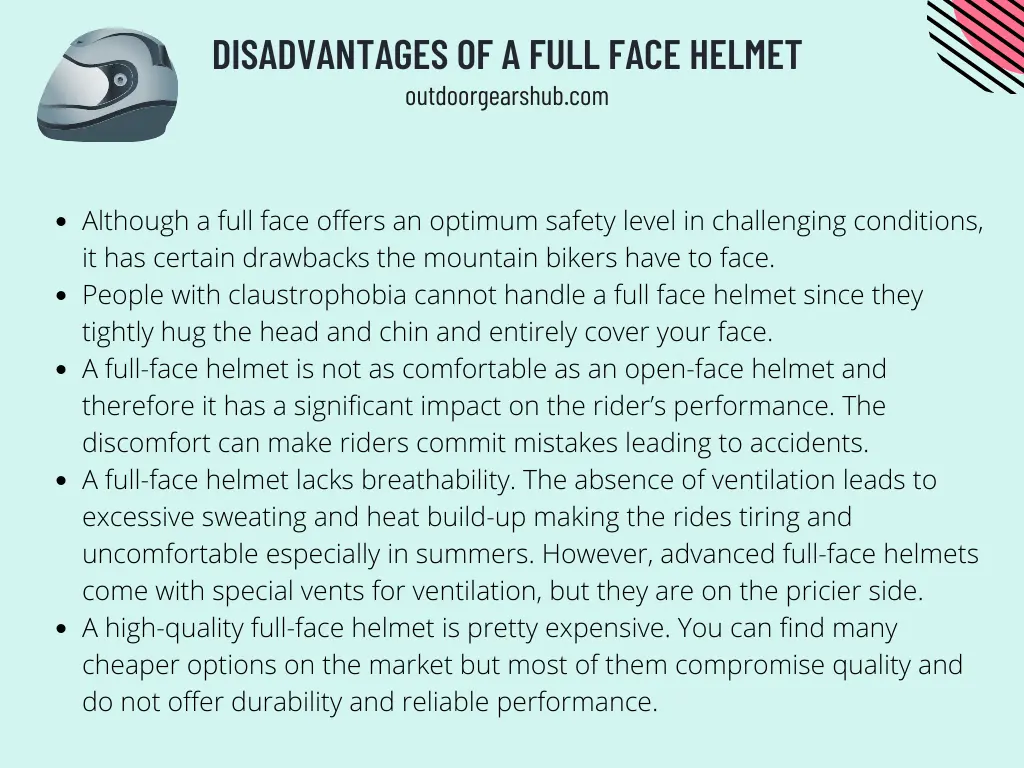When you are in the market to buy a mountain bike helmet, the debate of full-face vs. open-face helmets is a tough one. You have to choose from these two conventional types of mountain bike helmets. But before you make a purchase, it is critical to know the advantages and disadvantages of full-face and open-face MTB helmets.

Along with the pros and cons, you need to consider your riding style, the conditions in which you ride, the safety level that you require, your budget, and many other factors.
Contents
- Full Face vs. Open Face Helmet – Detailed Comparison
- Advantages of a Full Face Helmet
- Disadvantages of a Full Face Helmet
- Advantages of Open Face Helmet
- Disadvantages of Open Face Helmet
- Outcomes of Full Face and Open Face Helmet Comparison
- FAQs about Bike Helmets
- Concluding Open Face vs. Full Face Helmets Comparison
Full Face vs. Open Face Helmet – Detailed Comparison
To make your search easy, I have compiled this comparison to discuss everything you need to know about full-face and open-face helmets.
What Is A Full Face MTB Helmet?

A full face MTB helmet entirely covers your face, head, and neck. This type of helmet is adapted to achieve the optimum safety level during extreme mountain biking like downhill riding, enduro racing, dirt jumping, etc. A full-face helmet is often mandatory in extreme mountain biking, especially in high-speed racing.
What Is An Open Face MTB Helmet?

An open face helmet also known as a half-shell helmet only covers your head and leaves your face uncovered. Open face helmets are famous among bikers for their stylish sporty look, comfort, and stability. This type of helmet is adopted for the less aggressive cross country trail rides, beach rides, and road rides.
Advantages of a Full Face Helmet

- The biggest edge of buying a full-face helmet is that it guarantees maximum protection against injuries even in severe accidents.
- Full face helmets are made with the need of aggressive raiders in mind and they use a hard shell lining making them highly shock-absorbing, even in severe crashes.
- Full-face helmet MTB comes with a visor and chin guard that protects your skull, chin, and upper part of the neck
- Full face helmet MTB won’t let flies and bugs enter and fully protects your eyes and mouth for safe and flawless rides. Also, it protects your face from dust and debris.
- A full-face helmet is a perfect choice when you ride in cold conditions.
Disadvantages of a Full Face Helmet

- Although a full face offers an optimum safety level in challenging conditions, it has certain drawbacks the mountain bikers have to face.
- People with claustrophobia cannot handle a full face helmet since they tightly hug the head and chin and entirely cover your face.
- A full-face helmet is not as comfortable as an open-face helmet and therefore it has a significant impact on the rider’s performance. The discomfort can make riders commit mistakes leading to accidents.
- A full-face helmet lacks breathability. The absence of ventilation leads to excessive sweating and heat build-up making the rides tiring and uncomfortable especially in summers. However, advanced full-face helmets come with special vents for ventilation, but they are on the pricier side.
- A high-quality full-face helmet is pretty expensive. You can find many cheaper options on the market but most of them compromise quality and do not offer durability and reliable performance.
Advantages of Open Face Helmet

- The Biggest perk of buying an open-face helmet is that it offers incredible comfort. These helmets only cover your head leaving your face exposed and there they offer impressive ventilation and breathability.
- Therefore open face helmet is an ideal choice for long-distance rides in summers.
- Open-face helmets are lightweight and portable and riders love to carry them on outdoor adventures.
- Open-face helmets are less expensive than full-face helmets. Also, they can be used for multiple outdoor activities like skating.
Disadvantages of Open Face Helmet

- Open face helmets do not offer protection for the eyes, mouth, and skull. The advanced open helmet comes with detachable visor offering protection against flies, bugs, dust, and debris.
- Open-face helmets are lightweight and lack hard-shell lining making them less shock-absorbing.
- Open face helmets are not allowed in professional hard trail and mountain biking.
Outcomes of Full Face and Open Face Helmet Comparison
So from the above discussion, we can safely conclude that full-face MTB helmet offers a higher level of protection than open-face MTB helmet. A full-face helmet is a perfect option for new riders since they are more prone to accidents in challenging rides.
Although a full-face helmet is less ventilated and less comfortable than an open-face mountain bike helmet, it guarantees protection against deadly head injuries in every situation. However, if you are a skilled rider and looking for an inexpensive helmet for less challenging beach rides and road trips, an open-face helmet will do the job for you.
Face and eye protection is another major concern that you should consider in the debate of full-face vs. open-face MTB helmet. If you are going to buy an open-face helmet, a visor should be your top priority. A visor offers protection against bugs, mud, dust, and flies whereas full face helmet is highly recommended for downhill rides.
FAQs about Bike Helmets
Should I use a full face mountain bike helmet?
If you ride in hard terrains like downhill or challenging cross country tracks it is advised to use a full-face mountain bike helmet. A full-face mountain bike is often mandatory in high-speed racing and mountain biking events.
Does enduro rider need a full face helmet?
A full face helmet is mandatory in enduro racing at all stages. Enduro involves high-speed uphill and downhill riding and therefore full-face MTB helmet is mandatory to get an optimum safety level.
Is it OK to wear a half-face helmet?
It is okay to wear a half-face or open-face helmet on less challenging rides on the roads. A half-face helmet is a lightweight, highly breathable, and comfortable helmet that protects your head but leaves your face and skull exposed.
Concluding Open Face vs. Full Face Helmets Comparison
We are hopeful that this guide on full-face vs. open-face MTB helmet will help you understand the difference between these two conventional helmet types. As a conclusion of the debate, I would suggest you buy a full-face element for maximum protection and safety. It is advised to invest in a high-quality helmet for maximum protection, stability, and comfort.

Hi, I’m Alexandra Betty, co-founder of OutdoorGearsHub.com! I am a cycling enthusiast and currently living in Waltham, Massachusetts. I love just about everything about the cycling industry, which is why I created this site! Combining my passion with my work has always been extremely important to me. Feel free to reach out, leave comments, or recommend improvements to the site and its content so we can help you improve your cycling experience!
I am on a mission to enable everyone to spend more time on a bike and outdoors. So whether it’s on the road, gravel, mountain, e-biking, or just cruising around – Outdoor Gears Hub is the place to come for trusted advice.